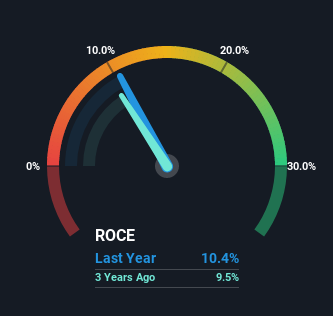A-Sonic Aerospace's (SGX:BTJ) Returns On Capital Are Heading Higher

What trends should we look for it we want to identify stocks that can multiply in value over the long term? One common approach is to try and find a company with returns on capital employed (ROCE) that are increasing, in conjunction with a growing amount of capital employed. Put simply, these types of businesses are compounding machines, meaning they are continually reinvesting their earnings at ever-higher rates of return. With that in mind, we've noticed some promising trends at A-Sonic Aerospace (SGX:BTJ) so let's look a bit deeper.
Return On Capital Employed (ROCE): What Is It?
For those who don't know, ROCE is a measure of a company's yearly pre-tax profit (its return), relative to the capital employed in the business. Analysts use this formula to calculate it for A-Sonic Aerospace:
Return on Capital Employed = Earnings Before Interest and Tax (EBIT) ÷ (Total Assets - Current Liabilities)
0.10 = US$4.9m ÷ (US$96m - US$49m) (Based on the trailing twelve months to December 2022).
Therefore, A-Sonic Aerospace has an ROCE of 10%. On its own, that's a standard return, however it's much better than the 5.1% generated by the Logistics industry.
See our latest analysis for A-Sonic Aerospace

While the past is not representative of the future, it can be helpful to know how a company has performed historically, which is why we have this chart above. If you'd like to look at how A-Sonic Aerospace has performed in the past in other metrics, you can view this free graph of past earnings, revenue and cash flow.
How Are Returns Trending?
A-Sonic Aerospace has recently broken into profitability so their prior investments seem to be paying off. About five years ago the company was generating losses but things have turned around because it's now earning 10% on its capital. And unsurprisingly, like most companies trying to break into the black, A-Sonic Aerospace is utilizing 93% more capital than it was five years ago. We like this trend, because it tells us the company has profitable reinvestment opportunities available to it, and if it continues going forward that can lead to a multi-bagger performance.
One more thing to note, A-Sonic Aerospace has decreased current liabilities to 51% of total assets over this period, which effectively reduces the amount of funding from suppliers or short-term creditors. So shareholders would be pleased that the growth in returns has mostly come from underlying business performance. However, current liabilities are still at a pretty high level, so just be aware that this can bring with it some risks.
Our Take On A-Sonic Aerospace's ROCE
Overall, A-Sonic Aerospace gets a big tick from us thanks in most part to the fact that it is now profitable and is reinvesting in its business. And a remarkable 366% total return over the last five years tells us that investors are expecting more good things to come in the future. With that being said, we still think the promising fundamentals mean the company deserves some further due diligence.
If you want to continue researching A-Sonic Aerospace, you might be interested to know about the 2 warning signs that our analysis has discovered.
While A-Sonic Aerospace isn't earning the highest return, check out this free list of companies that are earning high returns on equity with solid balance sheets.
New: Manage All Your Stock Portfolios in One Place
We've created the ultimate portfolio companion for stock investors, and it's free.
• Connect an unlimited number of Portfolios and see your total in one currency
• Be alerted to new Warning Signs or Risks via email or mobile
• Track the Fair Value of your stocks
Have feedback on this article? Concerned about the content? Get in touch with us directly. Alternatively, email editorial-team (at) simplywallst.com.
This article by Simply Wall St is general in nature. We provide commentary based on historical data and analyst forecasts only using an unbiased methodology and our articles are not intended to be financial advice. It does not constitute a recommendation to buy or sell any stock, and does not take account of your objectives, or your financial situation. We aim to bring you long-term focused analysis driven by fundamental data. Note that our analysis may not factor in the latest price-sensitive company announcements or qualitative material. Simply Wall St has no position in any stocks mentioned.
About SGX:BTJ
A-Sonic Aerospace
An investment holding company, engages in the aviation and logistics businesses in Asia, North America, Europe, and Sub-Continent India.
Flawless balance sheet with proven track record.
Similar Companies
Market Insights
Community Narratives



